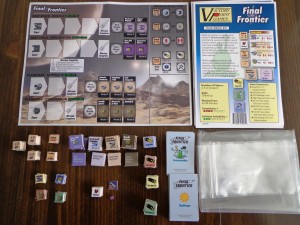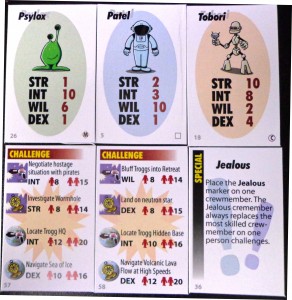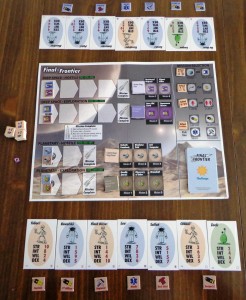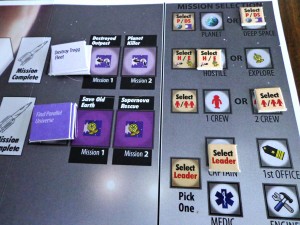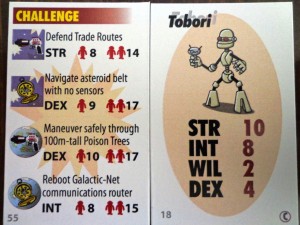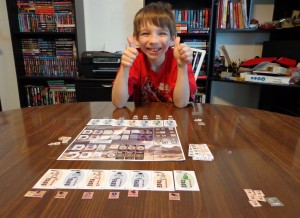Space…The Final Frontier. This phrase is uttered at least five times a week on my television, causing most of the people in the room to sigh loudly and take up a new hobby. Haters gonna hate I guess, but the idea of mankind growing to the point where disease, poverty, and war are no longer major issues has always been appealing to me. While researching and reviewing “Boom & Zoom” by Victory Point Games, I came across “Final Frontier” and was immediately interested, for obvious reasons.
Final Frontier tasks players with completing challenges so that they can earn victory points. Each player will have a captain and crew, each with their own statistical modifiers that are checked when attempting to complete said challenges. Before I go any further, I’d like to thank Stephanie Marroquin from Victory Point Games for sending me a free copy of Final Frontier for me to review.
Components
Mission Board – This is the main hub of activity, helping players to track their progress on the four mission tracks among other things.
Crew Cards – Each player will have a set of crew cards that have various stats on them. They are used when resolving challenges.
Challenge Cards – Each challenge card has the four possible mission types listed on them, and each mission type has a primary stat and point value that players will be trying to beat with their crew cards.
Special Event Cards – These cards are included in the challenge card deck, affecting players and gameplay.
Counters & Markers – There are a TON of markers and counters, consisting of basic & core mission counters, crew markers, bonus markers, mission markers, mission select markers, relationship markers, bonus VP markers, +1 VP markers, and the first player marker.
Die – The manual mentions that the game does not include dice, but one die was included with the game I received (albeit small, more on that later).
Setup
There are two ways to play this game. The easier of the two games is called “Academy Training”, designed to get the players’ feet wet. The “Five Year Mission” is the full game and takes a lot longer to play as it is more complex. To keep the review moving, I’ll briefly cover the “Academy Training” rule set and gameplay.
All you’ll need to play the simpler version is the mission board, the four mission select markers, the basic mission VP counters, the +1 VP counters, eight of the twenty-four challenge cards (random), mission markers, and crew cards.
You can see the full game setup on page two in the manual, which you can view here:
Gameplay
The object of the game is to have the most victory points when the game ends. The game is played over a series of rounds, each round consisting of one challenge that players will be attempting to pass and thus, earn victory points.
First, players will be taking turns selecting the mission parameters one at a time via the mission selection section of the main board. The top two mission parameters make up the four possible mission tracks on the left side of the main board. You’ll either have Planetary – Hostile, Planetary – Exploration, Deep Space – Hostile, or Deep Space – Exploration. The third mission parameter determines how many crew members (1 or 2) that players will be using to try and defeat the upcoming challenge, and the fourth mission parameter assigns a crew leader.
Second, players pick which crew member(s) they’ll be using. If only one crew member was picked on the third mission parameter, players must use the team leader assigned on the fourth mission parameter. Once all players have chosen their crew, a challenge card is drawn. A challenge card lists one of each possible mission types (four total) and the primary stat & value the crew members will need to pass it. One die is rolled by each player and that value is added to chosen crew’s primary stat…if the result is greater than the number on the challenge card, then the challenge is passed.
As a quick example, let’s say the mission chosen was Planetary – Exploration. Players are asked to pick two crew members where the team leader is the Captain. When the challenge card is drawn, players look at the Planetary – Exploration section and see that they need 15 Strength. Player One’s Captain and Engineer have a combined strength of 13 so he rolls the die and a 4 is rolled. 17 is greater than 15, so Player One passes the challenge. Each player must attempt the challenge in turn.
Passing a challenge awards a player a +1 VP marker which can be either applied to a crew member to improve their stats or as a VP to use for end game scoring. Their mission tracker marker also moves one space up the track. Should it reach the “mission complete” section, that player can draw the basic mission counter there and scores the victory points listed.
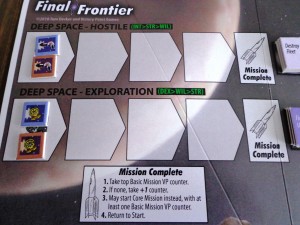
Completing challenges will allow you to complete missions…earning you some well deserved victory points.
Losing a challenge results in another die roll. If that second die roll is equal to or greater than the challenge, then no one on the crew dies. If the result is still lower than the challenge requirement, one crew member dies. No +1 VP markers are awarded either way.
Once the challenge is over and the appropriate markers moved / awarded, the round ends and the process begins again. Once all eight challenge cards have been resolved (over a total of eight rounds), the game ends and the player with the most victory points wins!
The above overview should give you a general idea of how the game is played, though if you’d like to learn more, you can check out the manual here:
The Review
First, I want to get the “dice” issue out of the way. The manual mentions that no dice are included in the game, which bothers me a little. Why not? Would including dice in the game’s components hurt profits that much? It’s worth noting however that a single die WAS included despite the manual, but it was so small that it was almost unusable. I almost lost it as I was initially taking the components out of the bag that the game came in. I found some of the counters and markers too small and really would have liked larger pieces, though that is just a personal preference. My fingers are not as slim or as nimble as they used to be and I had difficulty stacking and moving the markers / counters around. I suppose that’s why we have kids, right?

I compared a normal die (left) with the game’s die (right). Seriously, how am I supposed to use that?
The learning curve gave me a run for my money and I found the game to be moderately complex. The biggest hurdle I had was ascertaining which counter / marker was which. The manual does an OK job in helping to identify them, but I had a hard time separating the core mission counters from the basic mission counters. I eventually figured it and the basic game’s rules out, but it took about an hour or two. First time players will definitely want to try the easier game first, just to get used to how all of the markers and counters function. The normal game is a lot more complex, adding more than double the counters and markers you’d see in the easier game.
Once you get past the components and initial learning curve, you’ll find that Final Frontier has a lot to offer. There’s a bit of strategy involved in choosing the mission parameters, as each mission type has a stat it favors when challenges are drawn. Planetary – Hostile challenges often favor Strength and Dexterity, whereas Deep Space – Exploration challenges favor Dexterity and Willpower. If you have been improving a particular crew member during the game and they are particularly strong in certain areas, you’ll often be trying to pick mission types that compliment their stronger attributes.
Vinnie (11) had a lot of fun with the easier game and picked up the rules very quickly. Each time a challenge was about to be drawn, I could tell that he was carefully weighing his options in choosing the best crew members. While mission types favor particular stats, the stat that ends up being tested is not always guaranteed, which kept him on his toes. We both lost missions due to bad die rolls, but neither of us lost a crew member. He used a lot of his +1 VP points to improve his crew, which did turn out to his advantage a few times when the die didn’t favor him. I, on the other hand, pushed most of the +1 VP markers I won into my score pile.
Overall, the easier game took about a half hour to play. Players who attempt the Five Year Mission may want to set aside an hour or two. I’d recommend the former game variant for small children or for players wanting a casual play experience, and I’d recommend the latter for players who enjoy a challenge and have time for a longer, sci-fi themed game. As a Star Trek fan, I enjoyed the references, especially the “Red Shirt” crew member who you can sacrifice to prevent another crew member from being killed. If you enjoy sci-fi themed games and don’t mind a learning curve, then check this game out!
Final Verdict: 6/10
—
You can find more information on Final Frontier by visiting the Victory Point Games website or on Board Game Geek, located here:

